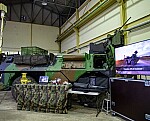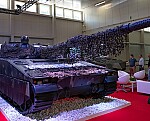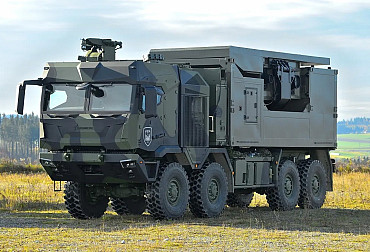France might want to develop its own Main Battle Tank within the MGCS project
In April France and Germany signed a memorandum of understanding aimed at relaunching their joint Main Ground Combat System (MGCS) project, which had been stalled by disagreements between the main manufacturers involved for nearly seven years.
Initiated in 2017 at the same time as the Scaf (Future Air Combat System), the MGCS is a Franco-German armaments programme. It aims to replace the German Leopard 2 tanks and the French Leclerc tanks, while incorporating the latest technological advances. Much more than a traditional heavy armoured vehicle, the MGCS is to be designed as a multi-platform system: a tank itself, equipped with a large-calibre gun, accompanied by other interconnected complementary modules (a heavy armoured vehicle equipped with powerful anti-tank missiles, a natively robotised support vehicle equipped with laser weapons, drones and other innovative weaponry).
To ensure a fair sharing of tasks, it was decided to reorganise the project into eight distinct capability pillars and to create a project company comprising KNDS France, Thales, KNDS Deutschland and Rheinmetall. As for the technological choices at the root of the quarrels between the manufacturers, they will only be made after an evaluation of the proposed solutions. This applies in particular to the gun of the future combat tank on which the MGCS will be based.
KNDS France has submitted the ASCALON (Autoloaded and SCALable Outperforming guN) system capable of firing 120 and 140 mm shells as well as intelligent ammunition for firing beyond direct sight. Rheinmetall is defending its 130 mm gun, which is to equip the turret of its KF-51 Panther tank, unveiled in 2022 at Eurosatory in Paris, and in the process of being selected by the Italian army.
This competition is now worrying some of the French MPs from all political parties. François Cormier-Bouligeon addressed the issue in his budgetary opinion on Programme 146, Equipping the Forces – Deterrence. The same goes for senators Hugues Saury and Hélène Conway-Mouret. In a recent report, they argued that ASCALON was in danger of being “sidelined from any prospect of commercialisation in order to preserve the leadership of Rheinmetall and KNDS Deutschland. This calls into question the very point of creating KNDS and, a fortiori, of continuing with the MGCS programme”, they even insisted.

The MGCS should not be seen as simply the successor to the Leclerc and Leopard 2 tanks, since it involves developing a family of systems (tanks, UAVs, robots, etc.). As this Main Ground Combat System is not expected to be operational before 2040 at the earliest, the question of keeping the Leclerc in service until then arises and is a frequent topic of debates. The same goes for a possible intermediate solution, designed to act as a bridge between the Leclerc and the MGCS. This was proposed by Nicolas Chamussy, CEO of KNDS France, in May 2023.
During a hearing on the war economy at the French National Assembly on 4 December, the Délégué général pour l'armement (DGA), Emmanuel Chiva, discussed the question of the future of the MGCS: “The heavy tank is a concern. First of all, I've said it before and I'll continue to say it today: we're not doing just anything, and we've obviously studied the possibility of extending the Leclerc until 2040. We are giving ourselves the means to give ourselves time. The MGCS is not the successor to the Leclerc and in no way prefigures the nature of the heavy tank. The MGCS is a land combat capability, with 'scorpionised' and 'dronised' wings in a combat cloud.” This could indeed pave the way for the coexistence of two different tanks within this system of systems.
Mr Chiva added: “You could say that the Germans could have a different heavy tank from the French heavy tank within the same project. I wouldn't be shocked. It would be financed from their own funds”, suggesting that the initiative would fall to KNDS France, which is promoting the Leclerc Evolution, equipped with the ASCALON system: “Within the framework of the MGCS project, what we are trying to achieve is a system architecture that will enable us to prepare for the combat system of the future. We are supporting our French champions, who are constantly innovating. I'm thinking in particular of the ASCALON cannon, which is a major innovation. We have a number of possibilities today that allow us to make up for the fact that production lines have been shut down. We can't solve all our problems in two years, but the Military Planning Act, as it applies to armoured combat, is designed to ensure that we don't have any capability gaps,” concluded Mr Chiva.
Why is the MGCS called tank of the future?
Artificial intelligence: The MGCS will be equipped with major technological breakthroughs such as AI. This will assist crews by providing support for intelligence, planning, command and fire coordination. All this data will be analysed to enable commanders to make rapid decisions. However, Martial, the capability architect in charge of the MGCS at the French Defence Procurement Agency (DGA), points out that “people will always be in the loop and at the heart of decision-making.”
Hyper connectivity: The MGCS will also be based on enhanced connectivity, enabling tactical information to be shared in real time via an integrated combat cloud. In this way, the various modules (or vehicles) will be able to process, store and distribute tactical data instantaneously and coordinate their actions semi-automatically to combine effects on the enemy.
What will the MGCS's main combat capabilities be?
Close combat: Capable of firing up to 8,000 metres, the MGCS's strike force will be increased tenfold. That's twice the current standard of the Leclerc tank. The number, mobility and simultaneity of the various modules accompanying the MGCS will increase their capacity to attack the enemy.
Observation: The MGCS system will enable observation from a distance of up to 10,000 metres, improving target spotting and anticipation capabilities.
Crew protection: Active camouflage, reinforced armour, countermeasures and neutralisation will be at the heart of the MGCS protection bubble to act against air and ground threats. Combined with the mobility afforded by the distribution of weapons and equipment on several separate platforms (thereby containing their mass), this bubble will make a significant contribution to the protection of combatants.
All these innovations will play a central role in the Titan project, which will succeed Scorpion from 2040. Its objective is to renew the decisive capabilities of the French Army and further extend the ambitions of collaborative air-land combat by linking it to the joint and combined levels.










